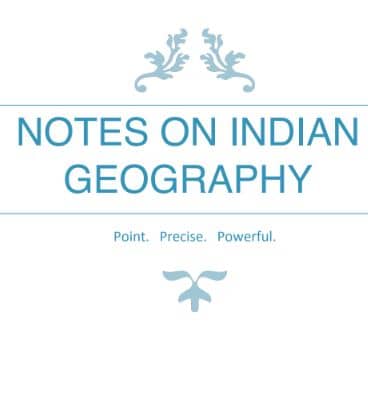‘Indian Geography’ PDF Quick download link is given at the bottom of this article. You can see the PDF demo, size of the PDF, page numbers, and direct download Free PDF of ‘Indian Geography’ using the download button.
Indian Geography Notes Book PDF Free Download

Here we are sharing with you the Indian Geography Notes & Study Material PDF. This geography pdf is very helpful for upcoming various competitive exams like UPSC, SSC CGL, CHSL, and other common written exams or objective exams.
Physiographic Division of Indian
India can be divided into six physiographic regions.
- 1) The Northern Mountains (The North and North-eastern Mountains)
- 2) The Peninsular Plateau
- 3) Indo Gangetic Plains
- 4 Indian Deserts
- 5) The Coastal Plains (East & West)
- 6) Island
1) The Northern Mountains (The North and North-eastern Mountains)
- The Himalayas consist of a series of parallel mountain ranges.
- The general orientation of these ranges is from northwest to the southeast direction in the north western part of India
- Himalayas in the Darjeeling and Sikkim regions lie in an east west direction
- While in Arunachal Pradesh they are from southwest to the northwest direction
- In Nagaland, Manipur and Mizoram, they are in the north south direction
- The approximate length of the Great Himalayan range, also known as the central axial range, is 2,500 km from east to west
- Their width varies between 160-400 km from north to south.
- Himalayas are not only the physical barrier; they are also a climatic, drainage and cultural divide.
On the basis of relief, alignment of ranges, and other geomorphologic features the
The Himalayas can be divided into the following sub-divisions
(i) Kashmir or North-western Himalayas
(ii) Himachal and Uttaranchal Himalayas
(iii) Darjeeling and Sikkim Himalayas
(iv) Arunachal, Himalayas
(v) Eastern Hills and Mountain
The Indian Monsoon
- The monsoons are experienced in the tropical area roughly between 20° N and 20° S.
- To understand the mechanism of the monsoons, the following facts are important. The differential heating and cooling of land and water creates low pressure on the landmass of India while the seas around experience comparatively high pressure.
(b) The shift of the position of Inter-Tropical Convergence Zone (ITCZ) in summer, over the Ganga plain (this is the equatorial trough normally positioned about 5°N of the equator- also known as the monsoon trough during the monsoon season).
Himachal or lesser Himalaya
The range lying to the south of the Himadri forms the most rugged mountain system and is
known as Himachal or lesser Himalaya.
The altitude varies between 3,700 and 4,500 metres and the average width is of 50 Km.
The Pir Panjal range forms the longest and the most important range
The Dhaula Dharand the Mahabharat ranges are also prominent ones.
This range consists of the famous valley of Kashmir, the Kangra and Kullu Valley in Himachal
Pradesh.
This region is well known for its hill state
Shiwaliks
The outer most range of the Himalayas is called the Shiwaliks.
They extend over a width of 10-50 Km and have an altitude varying between 900 and 1100 metres.
These ranges are composed of unconsolidated sediments brought down by rivers from the main Himalayan ranges located farther north.
Covered with thick gravel called Alluvium.
The longitudinal valley lying between lesser Himalaya and the Shiwaliks are known as Duns.
Dehra Dun, Kotli Dun and Patli Dun are some of the well-known Duns.
The word shiwalik has its origin in the geological formation found in and around a place called Sivawala near Dehra Dun
Which was once a headquarter of the Imperial Survey and which subsequently established its permanent headquarters at Dehra Dun.
Dehra Dun is the largest of all the duns with an approximate length of 35-45 km and a width of 22-25 km.
The Eastern Hills and Mountains
- These are part of the Himalayan mountain system having their general alignment from the north to the south direction
- They are known by different local names
- In the north, they are known as Pataki Bum, Naga Hills,
- In the south as Mizo or Lushai hills.
- Most of these ranges are separated from each other by numerous small rivers.
- The Barak is an important river in Manipur and Mizoram.
- The physiography of Manipur is unique by the presence of a large lake known as ‘Loktak’ lake at the centre, surrounded by mountains from all sides.
- Mizoram which is also known as the ‘Molassis basin’ which is made up of soft unconsolidated deposits.
- Most of the rivers in Nagaland form the tributary of the Brahmaputra.
- While two rivers of Mizoram and Manipur are the tributaries of the Barak River, which in turn is the tributary of Meghna;
| Author | – |
| Language | English |
| No. of Pages | 102 |
| PDF Size | 2.13 MB |
| Category | Education |
Related Posts
Indian Geography Notes PDF In Hindi
Indian Geography Notes PDF Free Download
